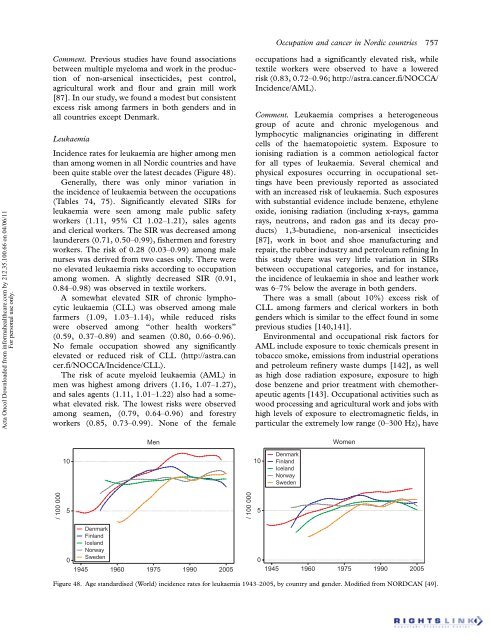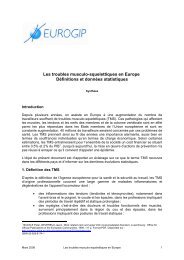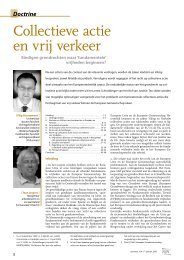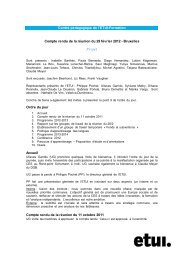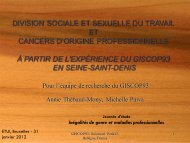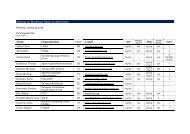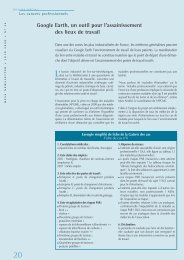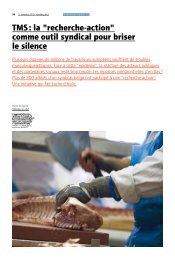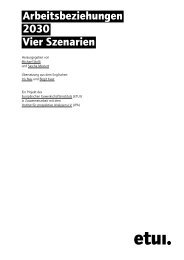Occupation and cancer - European Trade Union Institute (ETUI)
Occupation and cancer - European Trade Union Institute (ETUI)
Occupation and cancer - European Trade Union Institute (ETUI)
Create successful ePaper yourself
Turn your PDF publications into a flip-book with our unique Google optimized e-Paper software.
Acta Oncol Downloaded from informahealthcare.com by 212.35.100.66 on 04/06/11<br />
For personal use only.<br />
Comment. Previous studies have found associations<br />
between multiple myeloma <strong>and</strong> work in the production<br />
of non-arsenical insecticides, pest control,<br />
agricultural work <strong>and</strong> flour <strong>and</strong> grain mill work<br />
[87]. In our study, we found a modest but consistent<br />
excess risk among farmers in both genders <strong>and</strong> in<br />
all countries except Denmark.<br />
Leukaemia<br />
Incidence rates for leukaemia are higher among men<br />
than among women in all Nordic countries <strong>and</strong> have<br />
been quite stable over the latest decades (Figure 48).<br />
Generally, there was only minor variation in<br />
the incidence of leukaemia between the occupations<br />
(Tables 74, 75). Significantly elevated SIRs for<br />
leukaemia were seen among male public safety<br />
workers (1.11, 95% CI 1.02 1.21), sales agents<br />
<strong>and</strong> clerical workers. The SIR was decreased among<br />
launderers (0.71, 0.50 0.99), fishermen <strong>and</strong> forestry<br />
workers. The risk of 0.28 (0.03 0.99) among male<br />
nurses was derived from two cases only. There were<br />
no elevated leukaemia risks according to occupation<br />
among women. A slightly decreased SIR (0.91,<br />
0.84 0.98) was observed in textile workers.<br />
A somewhat elevated SIR of chronic lymphocytic<br />
leukaemia (CLL) was observed among male<br />
farmers (1.09, 1.03 1.14), while reduced risks<br />
were observed among ‘‘other health workers’’<br />
(0.59, 0.37 0.89) <strong>and</strong> seamen (0.80, 0.66 0.96).<br />
No female occupation showed any significantly<br />
elevated or reduced risk of CLL (http://astra.can<br />
cer.fi/NOCCA/Incidence/CLL).<br />
The risk of acute myeloid leukaemia (AML) in<br />
men was highest among drivers (1.16, 1.07 1.27),<br />
<strong>and</strong> sales agents (1.11, 1.01 1.22) also had a somewhat<br />
elevated risk. The lowest risks were observed<br />
among seamen, (0.79, 0.64 0.96) <strong>and</strong> forestry<br />
workers (0.85, 0.73 0.99). None of the female<br />
/ 100 000<br />
10<br />
5<br />
Men<br />
0<br />
Denmark<br />
Finl<strong>and</strong><br />
Icel<strong>and</strong><br />
Norway<br />
Sweden<br />
1945 1960 1975 1990 2005<br />
/ 100 000<br />
occupations had a significantly elevated risk, while<br />
textile workers were observed to have a lowered<br />
risk (0.83, 0.72 0.96; http://astra.<strong>cancer</strong>.fi/NOCCA/<br />
Incidence/AML).<br />
Comment. Leukaemia comprises a heterogeneous<br />
group of acute <strong>and</strong> chronic myelogenous <strong>and</strong><br />
lymphocytic malignancies originating in different<br />
cells of the haematopoietic system. Exposure to<br />
ionising radiation is a common aetiological factor<br />
for all types of leukaemia. Several chemical <strong>and</strong><br />
physical exposures occurring in occupational settings<br />
have been previously reported as associated<br />
with an increased risk of leukaemia. Such exposures<br />
with substantial evidence include benzene, ethylene<br />
oxide, ionising radiation (including x-rays, gamma<br />
rays, neutrons, <strong>and</strong> radon gas <strong>and</strong> its decay products)<br />
1,3-butadiene, non-arsenical insecticides<br />
[87], work in boot <strong>and</strong> shoe manufacturing <strong>and</strong><br />
repair, the rubber industry <strong>and</strong> petroleum refining In<br />
this study there was very little variation in SIRs<br />
between occupational categories, <strong>and</strong> for instance,<br />
the incidence of leukaemia in shoe <strong>and</strong> leather work<br />
was 6 7% below the average in both genders.<br />
There was a small (about 10%) excess risk of<br />
CLL among farmers <strong>and</strong> clerical workers in both<br />
genders which is similar to the effect found in some<br />
previous studies [140,141].<br />
Environmental <strong>and</strong> occupational risk factors for<br />
AML include exposure to toxic chemicals present in<br />
tobacco smoke, emissions from industrial operations<br />
<strong>and</strong> petroleum refinery waste dumps [142], as well<br />
as high dose radiation exposure, exposure to high<br />
dose benzene <strong>and</strong> prior treatment with chemotherapeutic<br />
agents [143]. <strong>Occupation</strong>al activities such as<br />
wood processing <strong>and</strong> agricultural work <strong>and</strong> jobs with<br />
high levels of exposure to electromagnetic fields, in<br />
particular the extremely low range (0 300 Hz), have<br />
10<br />
5<br />
<strong>Occupation</strong> <strong>and</strong> <strong>cancer</strong> in Nordic countries 757<br />
Denmark<br />
Finl<strong>and</strong><br />
Icel<strong>and</strong><br />
Norway<br />
Sweden<br />
Women<br />
0<br />
1945 1960 1975 1990 2005<br />
Figure 48. Age st<strong>and</strong>ardised (World) incidence rates for leukaemia 1943 2005, by country <strong>and</strong> gender. Modified from NORDCAN [49].


